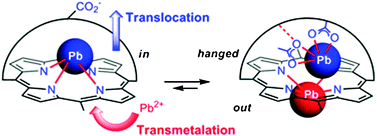Translocation-coupled transmetalation at the origin of a dinuclear lead porphyrin complex: implication of a hanging-atop coordination mode†
Abstract
Translocation of a

- This article is part of the themed collection: Porphyrins & Phthalocyanines

 Please wait while we load your content...
Please wait while we load your content...